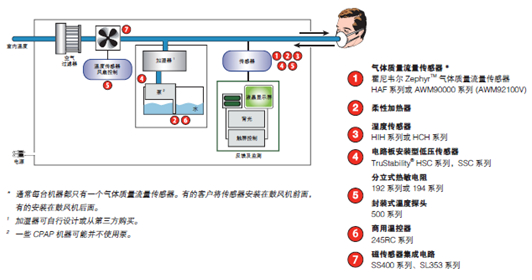Choose the right sensor to improve sleep ventilator efficiency, accuracy and reliability, and enhance patient comfort
Author: Honeywell Sensing and Control, global product director AJ Smith Sleep Apnea, commonly known as snoring, is a disorder that afflicts many people, which has a significant impact on their sleep. Treating this disease is a challenge for medical device manufacturers. Based on a solution to this problem, this article focuses on a variety of sensor solutions for sleep breathing apparatus and explains the differences between them, providing valuable technical insight to medical device manufacturers. Sleep apnea syndrome, a term commonly known as snoring, which causes millions of patients worldwide to worry about, is a recurrence of respiratory arrest during sleep, sometimes up to hundreds of times per night, usually up to a minute or so per time, or even Longer. If left unmanaged, will lead to memory loss and weight imbalance, but also cause high blood pressure and cardiovascular disease. The resulting lack of sleep and fatigue, but also may lead to work-related accidents and motor vehicle accidents culprit. One of the commonly used treatments is the use of positive pressure breathing (PAP) machines. The patient sleeps wearing a special mask to the pressure of the air into the patient's nose to avoid suffocation. There are three forms of this ventilator: CPAP (Continuous Positive Pressure Ventilator), constantly supplying a certain amount of pressure to the air. This positive pressure prevents obstruction of the upper airway caused by collapse of the upper airway during sleep, allowing the patient to breathe freely and avoiding apnea. Auto-PAP (Automatic Positive Pressure Ventilator) measures the resistance of a patient's breathing and adjusts the pressure required to empty the air based on the amount of resistance to ensure that every breath is clear and unobstructed. Bilevel PAP provides two types of pressure: positive and negative expiratory pressure. Picture Note: Sensors used on sleep ventilators to help control airflow, pressure, humidity and temperature, and stable motor control. Sensor type for sleep ventilator Image Note: Typical sleep breathing apparatus uses gas mass flow sensors, magnetic sensors, humidity sensors, temperature sensors and pressure sensors. Various types of sensors are used on sleep ventilators to monitor and help control airflow, pressure, humidity and temperature while supporting stable motor control.
The ceramic nozzle has different types ,the long ceramic nozzle ,the extra long ceramic nozzle ,the large dia. Ceramic nozzle ,and also the common ceramic nozzle .When the current pass through is greater ,the tig torch need the longer ceramic nozzle ,also the larger ceramic nozzle .We have several series of the ceramic nozzle ,the 13N ,the 10N ,the 54N,the 57N,the 14N,the 53N ,and so on ,they are suit for the tig torches .The custom can choice based on the tig torches they used .
Ceramic Nozzle, Tig Welding Ceramic Nozzles, 10N Ceramic Nozzle, 13N Ceramic Nozzle, 14N Ceramic Nozzle EDAWELD COMPANY LIMITED , https://www.jsedaweld.com

